Ford Kuga ST-Line X Edition 2.0 EcoBlue
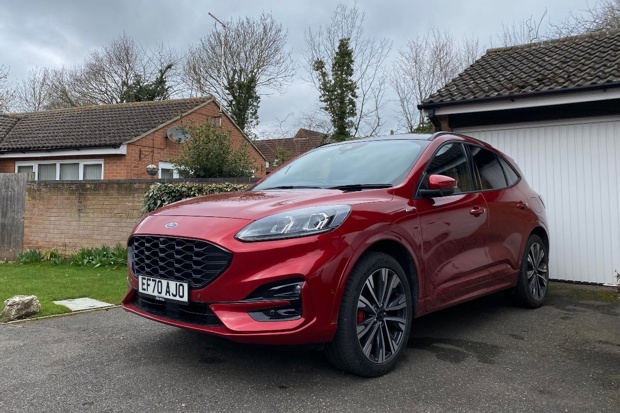
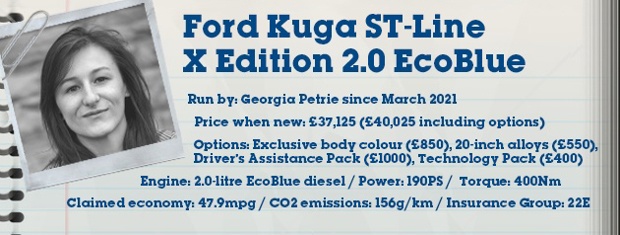
- Our Ford Kuga is here...and it's a diesel
- Are modern diesels still worth demonising?
- Hits and misses with Ford's convenient details
- The Ford Kuga is ready for self-driving. But are we?
- What's the 2020 Ford Kuga like to drive?
- Ford Kuga: New model versus previous generation
- Which Ford Kuga trim is best?
- Ford Kuga: Diesel versus plug-in hybrid
- How much does it cost to run the Ford Kuga?
- Farewell, Ford Kuga
Our Ford Kuga is here...and it's a diesel
Our £40k Ford Kuga has joined the HJ fleet.
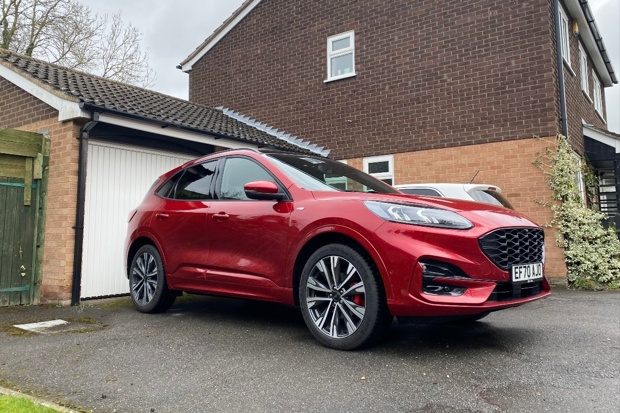
Date: 19 March 2021 | Current mileage: 607 | Claimed economy: 47.9mpg | Actual economy: 43.5
This week we’ve welcomed a new car to the Honest John fleet, a shiny new Ford Kuga. Our model is an ST-Line X Edition (fancy, we know) - which sits between the sporty ST-Line and top of the range Vignale trims. This means it gets 19-inch wheels (over the ST-Line’s 18-inch) and a power opening panoramic roof.
So, what does it cost? Well, the standard ST-Line X Edition trim goes for £31,565, but you can see ours is a considerable chunk more than that.
Upgrading to the 2.0-litre 190PS diesel engine paired with an 8-speed auto (plus the Lucid Red paint job) lifts the price to nearly £38k (£37,975). We then added 20-inch wheels, the Technology Pack (LED headlights and a heads-up display) and the Driver Assistance Pack (adaptive cruise control, active park assist, traffic sign recognition etc).
In total, our diesel Kuga costs a smidge over £40,000. You might be thinking that’s a lot for a Ford. And you’d perhaps be right, especially considering that cars with a list price of over £40,000 when new pay an additional £325 per year on top of the standard rate, for the first five years. Ouch.
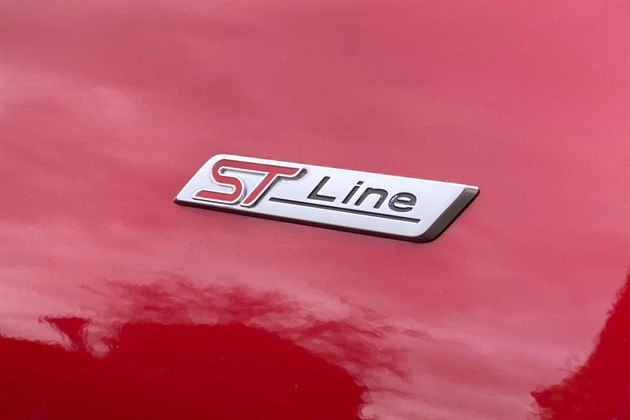
What else? Let’s talk ride handling and comfort. We haven’t run the Kuga long enough to make a big sweeping statement, but my first impressions certainly reinforce what I expected from a big Ford diesel: it’s a little bit loud and bumpy. But I wouldn't go so far as to call it unrefined.
Is it unbearable? Not at all. Will it grate on longer trips? Potentially - but I’ll keep you updated. The best ride comes with the softer suspension setup that's fitted to Zetec, Titanium and Vignale trims. It’s fairly settled on motorways but over potholes it can feel a tad stiff. Our advice is to take a test drive before you buy.
On the face of it, the Ford Kuga is exactly what drivers want. After all, it’s a huge SUV with tonnes of space, a range of engines (including a plug-in hybrid variant) and - like all Fords - a variety of trims to choose from. That said, the large SUV class is a crowded and competitive one. The Peugeot 5008, Honda CR-V, Toyota RAV4 hybrid and Mitsubishi Outlander PHEV all fit within the Kuga's price range.
Stay tuned for more updates to find out more about how we get along with our Ford Kuga in the coming months.
Are modern diesels still worth demonising?
Do the newest, cleanest diesel cars (like our Kuga) deserve the bad press they get? Georgia investigates.

Date: 31 March 2021 | Current mileage: 943 | Claimed economy: 47.9mpg | Actual economy: 44.5mpg
Our Ford Kuga is a 2.0-litre 190PS diesel. Now, saying we're running a diesel car shouldn't feel like admitting to a crime — but it certainly can do with all the bad press around diesel engines in recent years. If you're worried about buying a diesel car after the bad-mouthing that followed Dieselgate, higher tax rates and clean air zones news then you're not alone.
Used diesel car prices are falling due to the demonisation of the black fuel pump – which makes current prices tempting. But diesel cars only suit drivers that regularly cover a lot of high-speed miles, i.e. a regular motorway commute rather than lots of short trips.
Diesels are around 20 per cent more efficient than petrol so diesel cars should be cheaper to run in the long term, but only for drivers who go long distances or travel on motorways regularly. Otherwise, you risk DPF and EGR issues. If you regularly drive around town but want a car that can travel further afield, the PHEV Kuga might be a better option — especially as the sale of new hybrids won't be banned in the UK until 2025.
Modern diesels are also the cleanest yet, avoiding having to pay fees inside the UK's current and upcoming clean air zones. That's right, our 70-plate Kuga doesn't pay London's ULEZ fee (although, it does have to pay the congestion charge). That's because our Kuga's engine has a Euro emissions standard of Euro 6.2, which means it's a new, less polluting vehicle than older, dirtier diesels that are being banned for health reasons from city centres across the globe.
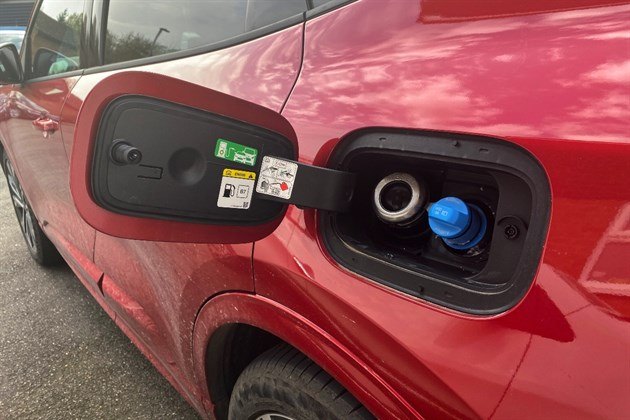
The future of diesel cars is yet to be known, but the carmakers that are continuing to include diesel engines in their ranges are ensuring they're less polluting than ever. However, Porsche has already shunned diesel engines, while Suzuki has paused supply of diesel engines for the UK market and Toyota is gradually taking its diesel models off sale.
On top of their superior fuel efficiency, diesels offer more torque than petrol vehicles. And our Kuga is no different, giving us 400Nm of torque on tap. The 1.5 EcoBoost (petrol) 150PS engine in the Kuga gives just 240NM, for comparison.
So, what's our opinion on diesel cars in 2021? Well, older diesel cars with high mileages are going to have a lot of issues that could be expensive to fix, especially if the owner before you has used the car in the wrong way and is selling it to avoid these imminent repair bills.
However, new diesel models are cleaner and more efficient than they were even three years ago. While the Government's current plan is to ban the sale of new petrol or diesel cars by 2030, you'll still be able to drive a diesel car or buy a secondhand one after these dates — meaning there's no reason why you shouldn't buy a modern diesel car now if it suits your needs.
Hits and misses with Ford's convenient details
Georgia runs you through Ford's door protectors, heated windscreen, powered tailgate, Active Noise Control and EasyFold system.
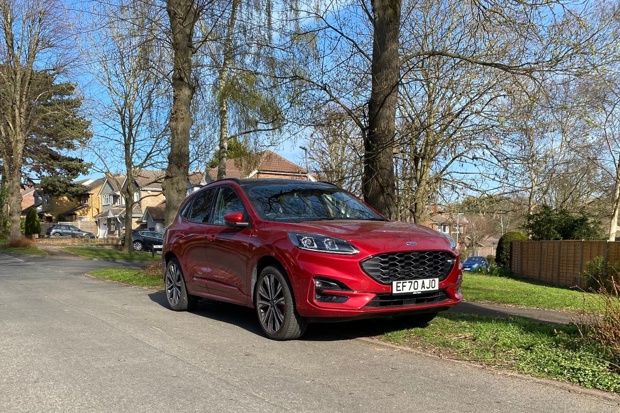
Date: 16 April 2021 | Current mileage: 1694 | Claimed economy: 47.9mpg | Actual economy: 43.6mpg
Half the fun (or stress, depending on your mindset) of choosing a new car is figuring out what you and don't want — especially if those convenient extras can significantly increase the list price of a vehicle. That's why I'm going to take you through which convenient details and touches are worth looking into on the Ford Kuga — or any Ford model, for that matter. Keep in mind, though, many of these are actually free.
First up: Ford's Door Edge Protector. Despite this little bit of plastic not adding much to my overall experience of living with the Kuga, it could make a BIG difference to the state of your door edges (and your anxiety levels) if you have kids that're prone to throwing the car doors open without looking.
It’s easy to bang your door against things in tight parking spaces. But open the door on the Kuga and a protective barrier springs out to shield the paintwork on your car and those alongside.
Up next, the hands-free, powered tailgate. It's ideal for effortless opening and closing if you’ve got your hands full, and the car senses the proximity of your KeyFree key-fob, all you have to do is wave your foot under the rear bumper and the tailgate will automatically open.
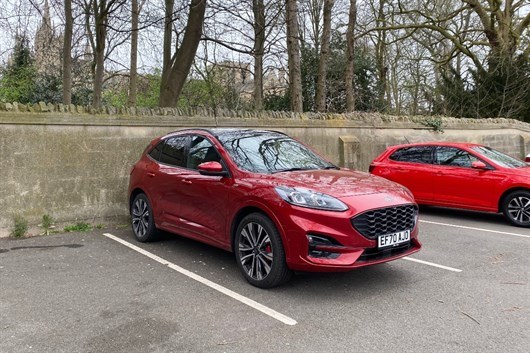
Ford's Quickclear Heated Windscreen is a boon on chilly winter mornings when I get outside, already running late, and find that I need to defront the windscreen before I can get going. Thankfully, the clever feature is designed to get you on the move quickly on frosty mornings.
With the touch of a button, ultra-thin filaments in the windscreen heat up to de-ice, de-fog and de-mist the windscreen as well as help de-freeze the wipers. The system works in seconds, even if it’s below zero outside.
Lastly, Ford's MyKey technology lets you set the maximum speed limit, set a seatbelt reminder and control the volume of the audio system — for example.
Just start the car, go into the vehicle settings, put the key in the designated location specified (the centre console) and then follow the instructions to programme the restrictions you want to set for that key.
The Ford Kuga is ready for self-driving. But are we?
Our Ford Kuga offers lane assistance technology, but this really mean the Kuga can be considered a 'self-driving' car?
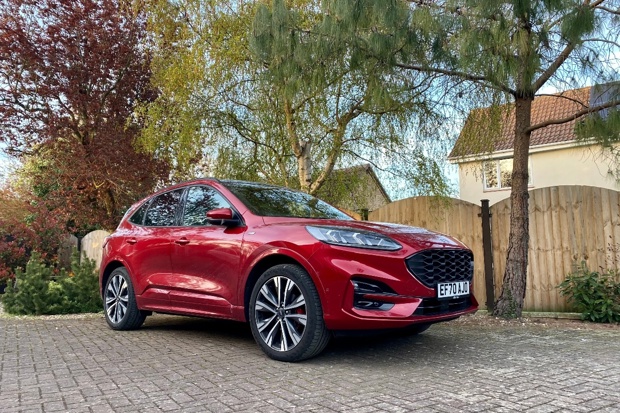
Date: 30 April 2021 | Current mileage: 2023 | Claimed economy: 47.9mpg | Actual economy: 46.4
Polls suggest that drivers are currently against the idea of autonomous vehicles, but I'm here to pose that maybe we're just having the wrong conversation. Controversial, I know...
In August 2020, a YouGov poll found that more than two-thirds of British drivers would be 'uncomfortable' with the prospect of driverless cars being allowed on motorways in 2021. Yet, as of April 2021, the Department for Transport (DfT) is laying out plans for vehicles equipped with Automated Lane Keeping Systems (ALKS) to be legally defined as ‘self-driving’.
The move would legalise hands-off operation of such cars up to 37mph, i.e. in a traffic jam. Some cars are already fitted with ALKS, but it's currently illegal for a driver to remove their hands from the wheel because these cars aren't classified as self-driving. Our Ford Kuga is one of these cars. However, the term is slightly misleading. Despite the phrasing being used in the wider media, the proposed ALKS technology is not fully driverless — it's intended use is as an advanced assistance system.
So, do I think the proposals are safe? Would I trust my Kuga to drive itself using its ALKS systems while I let my concentration lapse? Well, I suppose the question I'd sooner ask is, do I trust these systems less than I trust human drivers — including myself?
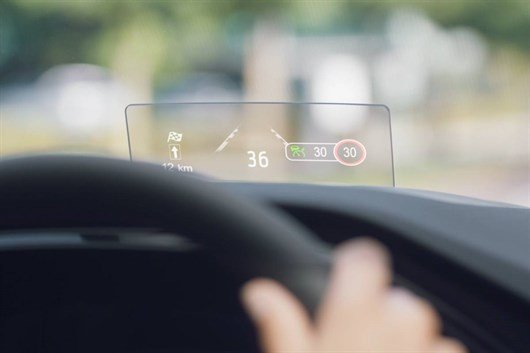
I have to admit, it can be a relief to let the machine bear more of the responsibility for boring motorway driving. But this was intended to be a first step along the path to full autonomy. The near-future, as I'm sure we've all seen, is a world imagined by the likes of carmakers where we read a book, eat a bacon bap, finish sending some work emails or simply nod off in a speeding car that drives itself from A to B. And it isn't all bad, not really. Let's not forget this has the potential to make our roads safer. Other than potentially avoiding collisions, keeping an eye on the road while the car drives itself is more restful than driving yourself because it reduces fatigue, one of the main causes of accidents.
This limits on our technological capabilites has led us to where we are now in 2021, with software that goes half way to what most of us would consider to be real 'self-driving'. It keeps my Kuga cruising at safe speeds; slowing down/speeding up and staying within its lane on the motorway (at any speed). The catch? I have to keep my hands on the wheel, as a visual and audible reminder on the dashboard note. But, by the end of the year, this might not be the case — not if I'm doing 37mph or less anyway.
However, there's still ambiguity over who or what is in charge at any time. My Kuga signals when it needs my assistance and, after a while, you get accustomed to the prompts and better at predicting when to override the software. But it's a new skill, and one that requires a willingness to learn.
A big danger with semi-autonomous driving is complacency: with people taking greater risks when they feel safer, even if that isn't the reality. The danger is getting stuck in the middle, as more cars are equipped with software that must be overseen by fallible humans. For example, in 2014, Volvo took one of the final steps towards realising its vision that by 2020 no one should be killed or seriously injured in a new Volvo car. To do this, the smart people at Volvo had to create a seamless 360-degree view around the car using sensors installed around the vehicle — cameras, radar, lidar, GPS, etc — to share information efficiently. And, despite this, Volvo models (like all others) still get into accidents. Why? Because humans are still in full control of driving them.
What's the 2020 Ford Kuga like to drive?
Georgia runs through handling, comfort, driving modes and more in this Ford Kuga update.
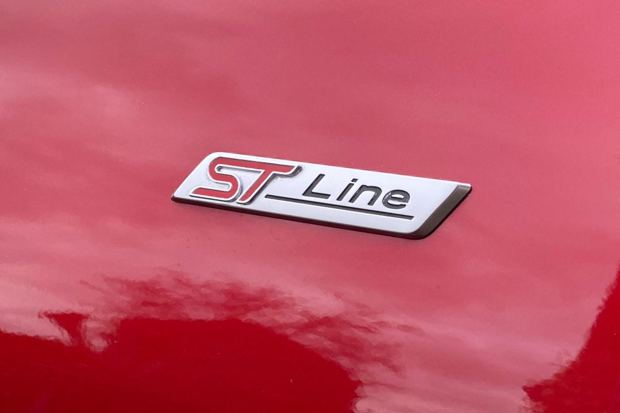
Date: 14 May 2021 | Current mileage: 2048 | Claimed economy: 47.9mpg | Actual economy: 47.7
If you want to buy a Ford because it handles well, you'd be barking up the right tree. In fact, for decades, Ford has offered some of the best handling vehicles on the market. From the original Ford Puma to the latest Fiesta ST – even humdrum cars like the Mondeo and Focus beat competitors when it comes to handling.
That being said, even Ford has its limits. If you're after a great handling car, we wouldn't recommend going out and buying a large SUV like the Kuga. It's not that it handles badly — in fact, it actually handles fairly well — but the sheer size and shape of large SUVs in general make them prone to plenty of lean and body roll.
On the plus side, our Ford Kuga feels very responsive, surefooted and predictable. There are times when the self-centering steering can cause a few issues, but this is a car that's designed to carry a lot of people and their things in comfort, not hurtle around with the modified Ford Focus crews you'd catch in the corner or a dimly-lit Tesco Extra car park.
Overall ride quality is good so you won't jar your back on pothole marked roads, but it can get a little bouncy at higher speeds in our Kuga.
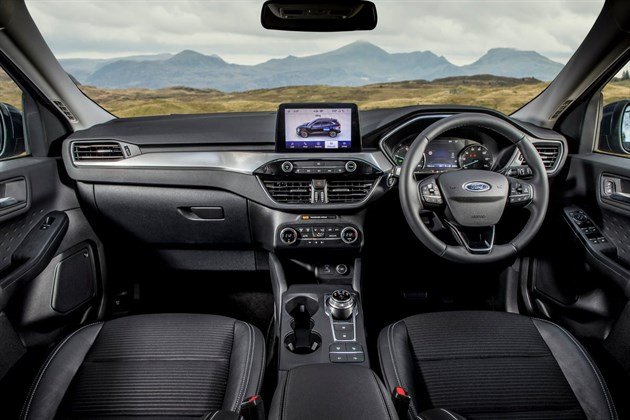
Most drivers will be happy with the standard set up, but the ST-Line models (which ours is) get a lower ride height and firmer springs, making them feel a touch more sporty and fidgety.
There's also a range of driving modes, including Eco, Sport, Wet/Slippery etc - which fine-tune vehicle performance to suit the conditions. The drive modes alter acceleration, steering and suspension, while also adjusting the traction and stability controls. We usually drive in Normal or Eco mode, switching into Sport when we want a bit more oomph.
We have the most potent diesel (the 190PS 2.0-litre) engine in our Kuga, which is sold exclusively with an eight-speed automatic gearbox and all-wheel-drive. It’s the only four-wheel-drive option, too, so expect to see it a lot if you frequent caravan holiday spots.
Overall, aside from the loud diesel engine thrumming away, especially at 30mph and under, we really like the Kuga. Granted, our £40k model has all the bells and whistles with a heads-up display, dual climate control, sunroof, Apple CarPlay etc - but we genuinely think the Kuga is much better than the previous generation. Plus, it can compete against some of the best rivals in the SUV class as long as you avoid the lower trims.
Ford Kuga: New model versus previous generation
Georgia compares the 2020-onwards Kuga with the previous-generation model.
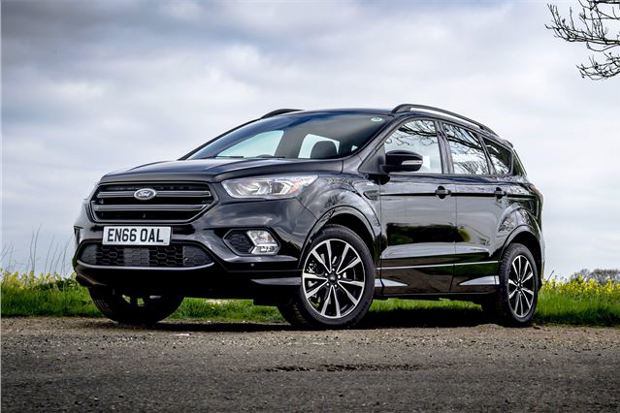
Date: 28 May 2021 | Current mileage: 2076 | Claimed economy: 47.9mpg | Actual economy: 47.9
As chance (or the the magical inner workings of press fleet management) would work, we ran a previous generation 2.0-litre diesel Ford Kuga ST-Line for six months in 2017. While I wasn't directly running that Kuga, it's certainly worth a comparison if you're looking to compare a used Kuga to a new or nearly-new model.
So, here goes. And where makes better sense to start than the prices. The previous-gen Kuga had an on-the-road price of £28,145 when it was new. For that sum, you could get 18-inch alloys, body kit, park assist and sensors, sports suspension, rain-sensing wipers, and quick clear heated windscreen. There’s also air-con, keyless start, cruise control, tyre pressure monitoring and electronic stability programme. Basically most the same stuff I have on the Kuga I'm currently running.
In 2017, our Kuga options included the Shadow Black paintwork (£545), large rear spoiler (£200) and panoramic sunroof (£900) giving ours a total on-the-road price £29,790. Unlike my new Kuga, there was no electronically-operated tailgate or keyless entry. The standard ST-Line X Edition trim goes for £31,565, but ours is a considerable chunk more than that.
That’s a lot for a Ford, especially considering that cars with a list price of over £40,000 when new pay an additional £325 per year on top of the standard rate, for the first five years. So, you better have deep pockets. But I would also say that this generation of Kuga is much better than the previous model. £10k better? I'll let you decide on that.
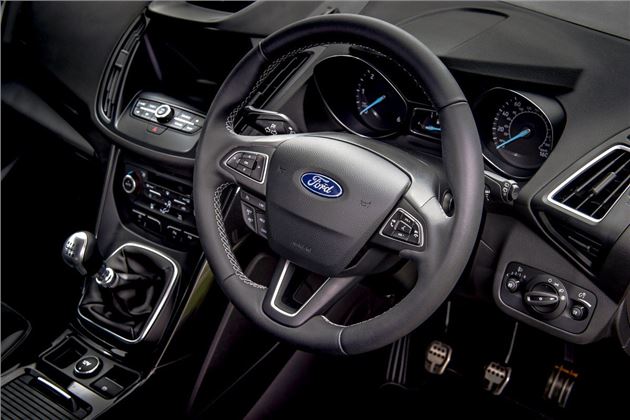
I mean, look at it... While the new model might not be to everyone's taste when it comes to SUVs, it's definitely better looking than the old Kuga (pictured above), in our humble opinion.
Longer and wider than the current model, the newest Kuga offers more room inside for front and rear passengers. Despite being lower, it also has more headroom than before. As for luxuries, rear passengers can get heated outer seats on the latest Kuga but not the only model.
In regards to fuel economy, the Kuga we tested in 2017 had an official fuel economy of 60mpg, yet saw just 38mpg disappointingly. Our current Kuga regularly sees over 47mpg, which is on par for the economy Ford claims. Being an SUV, the tank is also massive - meaning you won't have to stop for a few hundred miles if you fully top up.
While Ford has a reputation for making cars which are great to drive (mostly due to the handling), the previous Kuga was a bit sloppy. Fortunately for new Kuga buyers, the latest model is excellent with sharp handling ready to take on the Mazda CX-5.
Which Ford Kuga trim is best?
Georgia runs through the Kuga's trims to help you decide on the best value for money spec.
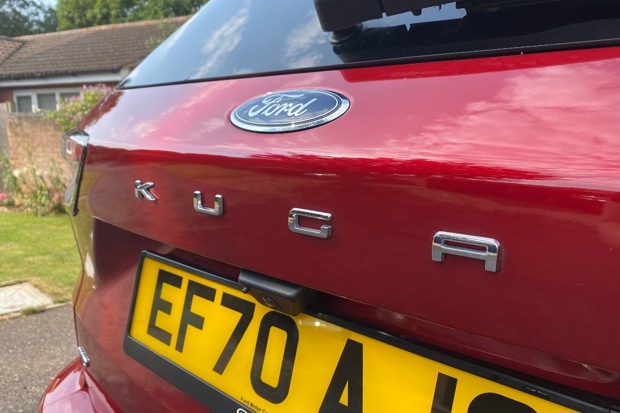
Date: 11 June 2021 | Current mileage: 2585 | Claimed economy: 47.9mpg | Actual economy: 47.9
The Kuga is available in five trim levels: Zetec, Titanium, ST-Line, ST-Line X and Vignale. Titanium offers more convenience and luxury features than the standard trim - which makes it popular - while ST-Line versions get a sportier bodykit and the like. Vignale is the most lavish option, sitting at the top of the range.
As we've mentioned previously, we're running a Kuga ST-Line. It's a very nice looking SUV with a fair share if swanky features. But, before we get into that, let's quickly run through the Zetec and Titanium trims, which are what most buyers opt for. After all, you can add the optional extras you want without necessarily upgrading to another trim level. For example, we have a panormaic roof spec'd.
For starters, bog standard Zetec isn't as bare as you might think. Buyers get 17-inch alloy wheels, LED day time running lights, privacy glass and silver roof rails, Ford SYNC3 (with DAB and Nav), front and rear parking sensors, and Pre-Collision Assist with Autonomous Emergency Braking. Starting at £24,445, it isn't bad at all for those on a budget. Although, it isn't exactly stylish...
Step up to Titanium (which I'd recommend) and you get 18-inch wheels, a hands-free power tailgate, digital 12.3-inch instrument cluster, B&O Premium audio system and a Rear View Camera. The addition of these things - as well as Apple CarPlay and Android Auto - would be enough for me to suggest this trim, though it does start at £28,345 - which is a steep increase.

The third trim is ST-Line (pictured at this glamorous car wash), starts at £30,145 and offers Sensico sports seats with red stitching, a flat-bottom steering wheel and a 10-way power adjustable driver’s seat. Plus, alloy pedals, black roof rails and red brake calipers, climate control, ambient interior lighting, an eight-inch touchscreen display with sat-nav and automatic high beams.
Frankly, it's harder riding than the Titanium model so if you value comfort over sport or performance then stick with Titanium or - if your burget allows, Vignale is a premium trim. For those that want an attractive, sporty SUV - we've very much enjoyed the ST-Line.
The ST-Line X model (priced at £31,580) builds on the ST-Line with larger 19-inch alloy wheels, heated seats and a heated steering wheel. Lastly, Vignale is the most luxurious trim and isn't hugely popular due to the £32,880 starting price. If you are interested, Ford promises unrivalled refinement with 19-inch alloy wheels, LED lights, chrome bumper trim, tinted rear windows and various other creature comforts found in lower specs - like a heated leather-trimmed steering wheel, dual-zone air con and a wireless phone charging pad.
You also get a head-up display, active noise cancelling, active park assist and an 8-inch touchscreen infotainment system with sat-nav, smartphone mirroring and an upgraded 10-speaker B&O stereo as standard. Fancy, innit.
Ford Kuga: Diesel versus plug-in hybrid
Georgia puts a plug-in hybrid Kuga through its paces.
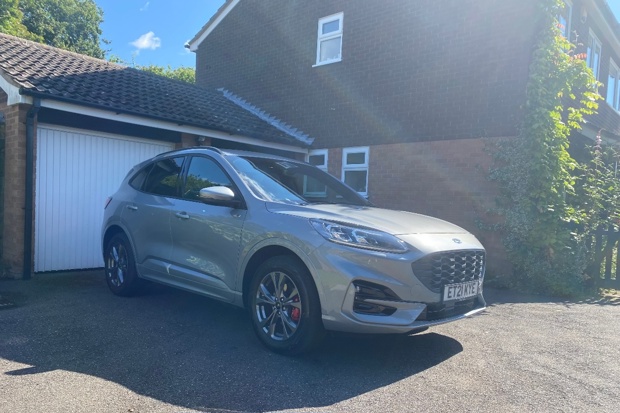
Date: 9 July 2021 | Current mileage: 3469 | Claimed economy: 47.9mpg | Actual economy: 47.9mpg
This week, we put our diesel Kuga to the test — comparing it to the plug-in hybrid (PHEV) Kuga variant in the same ST-Line trim. Straight off the bat, the Kuga PHEV is a lovely looking thing. Like our diesel model, the PHEV ST-Line Kuga offers plenty of kit, including sportier styling, 18-inch alloys and black roof rails. That’s in addition to the Titanium trim's LED lights, climate control and B&O stereo.
Inside, the Kugas are very similar, as you might expect. You can see the diesel Kuga's interior in this update. It's set up near-identically in the cabin, with an extra button for EV mode selection on the centre console. This lets you choose between the four settings for the electric drivetrain: EV Charge tops up the battery using the engine, while EV Now prioritises any remaining electric energy. EV Later holds the state of charge and EV Auto uses the car’s electronics to determine the most efficient combination of petrol and electric power.
We mostly relied on the EV Auto setting, however, each mode is useful at times. EV Charge, for example, uses the engine to top up the battery so we’d avoid this unless you’re due to enter a built-up area or low-emission zone. If you have a couple of miles left of charge, it might be useful to use EV Later mode to cover the rest of your journey in a city under electric power - even if you aren't there yet.
If you use the petrol engine a lot, you’ll quickly realise that lugging around a big battery without being able to use it all the time lowers fuel efficiency. When you want a bit more oomph or when the charge is depleted, the engine is a little intrusive when it kicks in, and the CVT gearbox doesn’t do the driving experience any favours. But some good news is that it keeps many of the diesel’s favourable traits: the steering is sharp and the SUV rides well more such a large car.
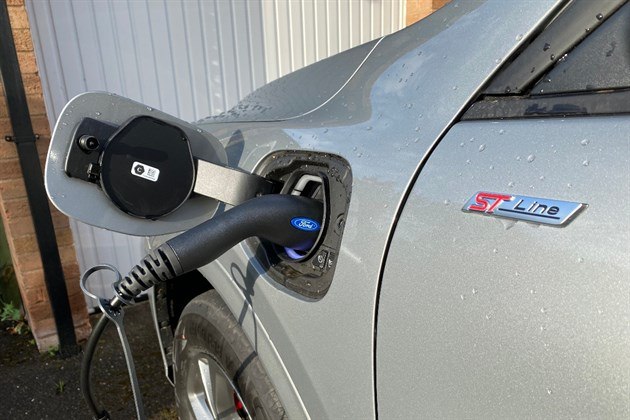
The Ford Kuga PHEV feels at its best when running around on pure electric, which makes it a shame that it only has a usable electric range of 35 miles (though 30 miles or slightly less is more realistic).
The hybrid SUV only takes 3.5 hours using a 7.4kW home wallbox. That's the fastest option, though. If, like us, you don't have a wallbox at home then you'll be looking at six hours from a standard three-pin plug - which is easy enough to remember to plug in when we're heading to bed. It's certainly a simple and cheap way to add 30 miles to our 'tank'. It's plenty useful on the condition that you can regularly charge the Kuga at home. Flat-dwellers and street parkers beware, if you want to use a public charge point, you’ll need to specify the relevant cable from Ford at a cost of £195...
Using the electric battery, the Kuga will move off in near-silence. The refined hybrid powertrain, plus the Kuga’s raised driving position and good visibility, makes it very easy and comfortable to drive, even around town. Similarly, in traffic jams, sitting in a near-silent car is a much more enjoyable experience than listening to the rumble of a diesel engine.
If you’re regularly driving long distances or live somewhere without access to off-street parking, then one of the cheaper diesel or petrol models is likely to be a more cost-effective consideration. Charging the PHEV on a daily basis will show the car in its best light; there’s no quick-charge capability.
How much does it cost to run the Ford Kuga?
Fuel costs, road tax, insurance — Georgia explains.

Date: 25 June 2021 | Current mileage: 3147 | Claimed economy: 47.9mpg | Actual economy: 47.9
Fuel costs, road tax, insurance — let's get into it.
We're currently running a 2.0-litre 190PS diesel, which is pretty economical (nearly 48mpg) for such a hulking SUV. High-mileage drivers should look for a Kuga with one of the EcoBlue diesel engines, but the 1.5-litre could be more sensible for real-world economy. The 2.0-litre mild-hybrid diesel can see up to 56.5mpg.
Don't forget that, being a diesel, our Kuga will need topping up with AdBlue every once in a while as well. If you don't know, AdBlue is a colourless liquid (water and urea) that converts nitrogen oxide emissions in the exhaust gas of diesel engines into nitrogen and water. Our Kuga, for example, has a second, smaller blue filler cap for AdBlue just beside the main fuel filler cap.
As for the petrol options, the 150PS Kuga 1.5-litre EcoBoost returns up to 42.8mpg, while the entry-level 120PS unit officially achieves 42.2mpg in WLTP economy tests. There's also a plug-in hybrid Kuga, which officially returns 201.8mpg — although this won’t be achievable unless you charge it regularly and cover most of your journeys under electric power alone. Essentially, that means mostly town driving and short trips at 30mph or less.
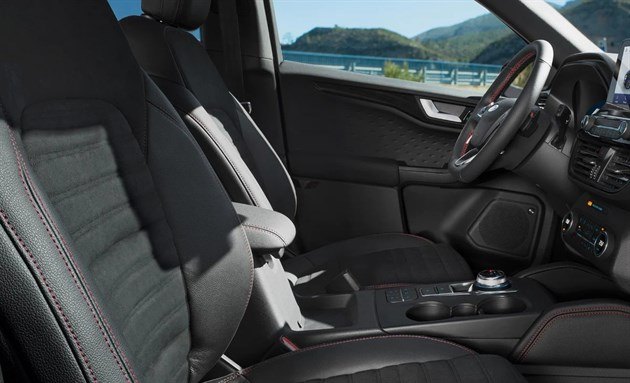
As for road tax, the first year's VED is based on emissions. It's also included in the 'on the road' (OTR) price. After that, you pay a flat rate of £150 per year. The exceptions to this are hybrids, which qualify for a £10/year discount. Therefore, most Ford Kuga models will cost a flat rate of £150 a year in tax after the first year, apart from the mild-hybrid and plug-in hybrid models - which see the discount.
However, cars with a list of price of more than £40,000 are taxed an extra £325 a year for five years (after the first year). So, it's worth buying an SUV with a list price below £40,000 (Ford Kuga, hint hint) as it can save you a significant amount of money in the long run. You can see the prices for different trim levels in our previous update.
The cheapest Ford Kuga to insure will be the basic Zetec model with the 1.5-litre Ecoboost petrol engine. This falls into insurance group 10. A plug-in hybrid or an all-wheel drive diesel will jump up to 19 or 20. Top of the range Vignale models see Group 21 or 22 status.
That won't be cheap to insure but it's still a long way from Group 50...
Farewell, Ford Kuga
Georgia says goodbye to the lovely Ford Kuga.

Date: 23 July 2021 | Current mileage: 3920 | Claimed economy: 47.9mpg | Actual economy: 47.9mpg
All good things must come to an end. And so, with that, I bid goodbye to my Ford Kuga with these final thoughts.
If you've dismissed Fords in the last few years, maybe you should reconsider. Aside from being extremely popular (mostly the Fiesta...) — which makes Fords easy to find, as well as allowing you to be picky about used models — Ford vehicles have come a long way in the last three to four years.
They've always handled well, but the engine in our Kuga (and the engine range in general) makes them worth a look, as does the genuinely nice interior. Okay, it isn't an Audi inside, nor a BMW when it comes to performance, but it's a great choice nonetheless. Servicing should also be cheap, with parts availability being a non-issue.
When it comes to the Kuga we've been running more specifically, I've been impressed. It's a nice looking thing, returns good fuel economy for its size (nearly 48mpg) and offers good performance on the move. The diesel model isn't hugely refined, especially at low speeds when we hear the engine thrumming away — but a petrol will definitely suit some buyers better. And, frankly, if refinement isn't top of your list, you may find the other factors make the Kuga the ideal all-rounder.
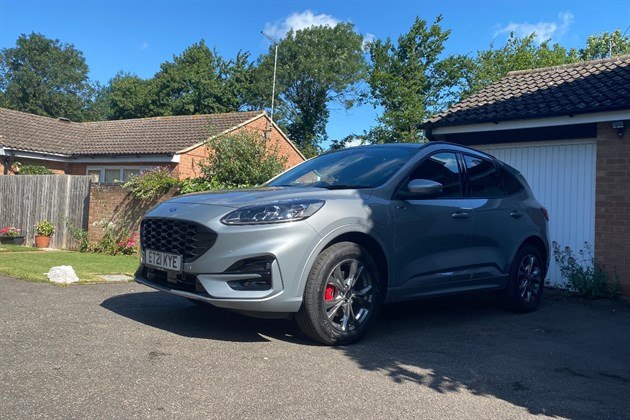
Space won't be a problem by any means, nor will comfort as long as you spec the car right. Speaking of which, I would skip the lowest spec'd Zetec trim all together and opt for ST-Line for the more sporty amongst you, or Titanium for those who want more creature comforts. You can read a more thorough breakdown of the Kuga's trims in this update.
To reiterate the ever-important aspect of prices, our Kuga is an ST-Line X Edition— which sits between the sporty ST-Line and top of the range Vignale trims. That means it gets 19-inch wheels (over the ST-Line’s 18-inch) and a power opening panoramic roof. The standard ST-Line X Edition trim goes for £31,565, but ours tops out at a lot more than that - having upgraded to the 2.0-litre 190PS diesel engine paired with an 8-speed auto, Lucid Red paint job, 20-inch wheels, the Technology Pack (LED headlights and a heads-up display) and the Driver Assistance Pack.
In total, our diesel Kuga costs a smidge over £40,000. That's a considerable amount of money for a non-luxury brand, especially considering that cars with a list price of over £40,000 when new pay an additional £325 per year on top of the standard rate, for the first five years.
Still, it succeeds at being a huge SUV with tonnes of space for a family and all their things, a range of engines (including a decent plug-in hybrid variant) and - like all Fords - a variety of trims and extras to make your Ford as tailored as you want. With that said, the large SUV class is a crowded and competitive one, with the Peugeot 5008, Honda CR-V, Toyota RAV4 hybrid and Mitsubishi Outlander PHEV all fitting within the Kuga's price range.
